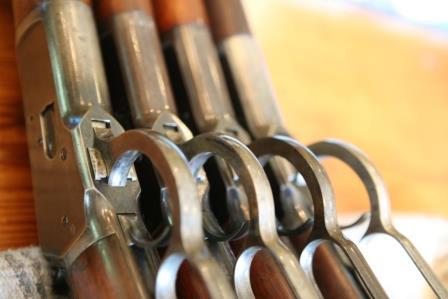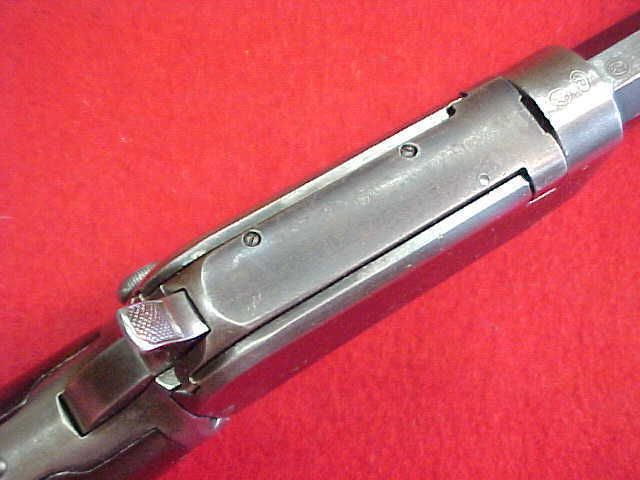March 20, 2009
 Offline
OfflineHello guys,
I came across this rifle in an auction listing and the “Oval P” stamp on the receiver struck me as an odd position. We have all seen them positioned on the barrel and apparently signifying a non factory replacement barrel put on the rifle. Any guesses as to why this stamp would be placed on the receiver top? Was this a frame sold to non factory smiths for their use? https://www.liveauctioneers.com/item/39979360_winchester-pre-war-model-94-lever-rifle-30-30
Michael

Model 1892 / Model 61 Collector, Research, Valuation
April 23, 2012
 Offline
OfflineI think what has happened in these circumstances of seeing both the mail order stamp and the Win in house repair stamp on the same component is this . The gun was sent to the Winchester factory for repair.
The mail order parts (already outside stamped oval P ) are in Winchester stores department ready to be shipped for gunsmith orders. When a in house repair is being done and a un stamped part is not available, the quickest way is to get a part from stores (or Mail Order Department ) with the outside stamp applied. Then when the repair is done in house. It is also stamped with the different in house stamp as well ,hence the 2 stamps
This is quite common in re-barrelling. but in this case the receiver was replaced in house for some reason , with an on hand mail order part, and when re-assembled ,also stamped to indicate in house fitted
Phil

May 2, 2009
 Offline
OfflineSerial numbers were not required until the Gun Control Act of 68
Bob
WACA Life Member--- NRA Life Member---- Cody Firearms member since 1991 Researching the Winchester 1873's

Email: [email protected]
March 20, 2009
 Offline
OfflineHello,
The serial number puts the DOM of the receiver in the year 1922. The barrel address on the gun is located on the top of the barrel and is of a style that in the Model 1892 series was used very early in the production history. If the same usage applied to the 1894/94 line of rifles then the barrel and receiver dates are quite a bit off.
Michael

Model 1892 / Model 61 Collector, Research, Valuation
April 23, 2012
 Offline
OfflineBert
The single oval P only would certainly indicate an outside replacement for sure , but how would the the official in house Winchester proof also get stamped onto the part if done outside? And what would be inferior about using a part from the Mail order Department? If there were parts already in stock, ready to go ,why would any foreman under pressure delay waiting for a new part to be made especially on a rush order.
Granted I am talking about how more modern factories I worked in would complete an order , but what would the difference be back then for the simplest quickest solution for work order processing ?
Phil

April 23, 2012
 Offline
OfflineI do believe that Winchester would sell and ship any part , as evidenced by the price lists of component parts shown in old catalogs ,
BUT , I dont believe any component , including Replacement barrels could be possibly be sent out with the ‘In House installed proof stamp’ on it as well . Only the single oval P
Phil

April 15, 2005
 Offline
OfflinePhil,
Based on the location of the two proof marks, it is my belief that the receiver in question was originally destined to be a standard production piece. The (P) proof mark was added after the receiver was originally proofed, but before it was shipped out the door to fill the mail order request. I am basing my theory on its stamped position below/behind the standard proof mark. I suspect that an order came in for a replacement receiver frame, and Winchester pulled one from a Model 94 that was already assembled (tested) and proofed. Keep in mind that Winchester maintained a positive supply (flow) of receivers for the assembly room, and there were always completed unsold guns sitting in the warehouse. Your theory is making the assumption that Winchester ran out of parts for regular production and that they had no complete guns sitting in the warehouse that could be used to fill an order. I simply do not agree that was a likely scenario.
Edited
Bert
WACA Historian & Board of Director Member #6571L

March 20, 2009
 Offline
OfflineI would offer a slightly different theory for the receiver. I find it hard to believe that Winchester would disassemble a fully manufactured rifle to cannibalize the receiver from it. It makes a bit more sense to me that they would assemble a new receiver, slap it on to a “test barrel” and after passing the proof firing then they would have proofed the receiver and then applied the “Oval P” mail order proof stamp before shipping it out. This would clear them from liability of shipping an inferior receiver to be used.
Michael

Model 1892 / Model 61 Collector, Research, Valuation
April 23, 2012
 Offline
OfflineThe likely theory that the two distinctly different stamps were adopted for the reason of Winchester service and warranty department to differentiate at a glance whether outside fitted (oval P only) therefore No Winchester liability for headspace or other function issues for work done by outside sources , but if the barrel or receiver only ,(or also ) had the in house stamp, then next step would be to determine if Winchester in house is at fault for manufacturing or assembly irregularity, or customer abuse is the issue,
So I dont think it would be in Winchesters best interest to sell any part for outside replacement that would indicate in house fitting and proof testing, if it was not in house fitted and proofed
In the case of the commonly seen both type of stamps on replacement barrels . I cant understand or follow the concept that all these barrels would be disassembled from assembled guns with the in house stamp , and then be additionally stamped with the outside oval P as a standard procedure , to be sold as a replacement part for outside fitting,? Or how would they have the two stamps on them ?
I dont claim to have a fraction of the knowledge of the helpful experts on this forum, but appreciate the opportunity to debate issues on a congenial level .
Phil

April 15, 2005
 Offline
Offlinetwobit said
I would offer a slightly different theory for the receiver. I find it hard to believe that Winchester would disassemble a fully manufactured rifle to cannibalize the receiver from it. It makes a bit more sense to me that they would assemble a new receiver, slap it on to a “test barrel” and after passing the proof firing then they would have proofed the receiver and then applied the “Oval P” mail order proof stamp before shipping it out. This would clear them from liability of shipping an inferior receiver to be used.
Michael
Michael,
That is a plausible theory.
Bert
WACA Historian & Board of Director Member #6571L

1 Guest(s)


 Log In
Log In








